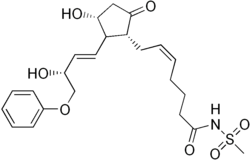Sulproston
| Structural formula | ||||||||||||||||||||||
|---|---|---|---|---|---|---|---|---|---|---|---|---|---|---|---|---|---|---|---|---|---|---|

|
||||||||||||||||||||||
| General | ||||||||||||||||||||||
| Non-proprietary name | Sulproston | |||||||||||||||||||||
| other names |
|
|||||||||||||||||||||
| Molecular formula | C 23 H 31 NO 7 S | |||||||||||||||||||||
| Brief description |
colorless to brownish liquid |
|||||||||||||||||||||
| External identifiers / databases | ||||||||||||||||||||||
|
||||||||||||||||||||||
| properties | ||||||||||||||||||||||
| Molar mass | 465.56 g mol −1 | |||||||||||||||||||||
| Physical state |
liquid |
|||||||||||||||||||||
| solubility |
soluble in DMSO |
|||||||||||||||||||||
| safety instructions | ||||||||||||||||||||||
|
||||||||||||||||||||||
| Toxicological data | ||||||||||||||||||||||
| As far as possible and customary, SI units are used. Unless otherwise noted, the data given apply to standard conditions . | ||||||||||||||||||||||
Sulprostone is a synthetic prostaglandin E2 derivative that causes the smooth muscles of the uterus to contract but dilates the cervix uteri . It is used as a medicinal substance in preparation for an instrumental evacuation of the uterus ( abortion , treatment of a restrained abortion ) or for the treatment of atonic uterine bleeding if the administration of oxytocin and the surgical measures are not sufficient to stop the bleeding.
Sulprostone relatively often leads to nausea and vomiting , in rare cases serious complications, such as pulmonary edema or cardiac arrhythmia, or even cardiac arrest can occur. Spasms of the coronary arteries with subsequent heart attacks are also possible, though rare.
Sulproston is administered intravenously as continuously as possible . The dose should not exceed a dose of 500 μg / h. The maximum daily amount is a total of 1500 μg / 24 h.
In the case of postpartum atonic uterine bleeding , 100 μg / h are applied initially, up to a maximum of 500 μg / h. After the therapeutic effect has started, the amount administered intravenously is reduced to the maintenance dose of 100 μg / h, taking into account the maximum daily amount.
The drug should not be used in patients over 35 years of age or with existing coronary sclerosis . It must not be given at the same time as oxytocin .
Pharmacokinetics of the prostaglandin E2 derivative sulprostone
Pharmacokinetically , one has to distinguish the phase of distribution ( distribution ) of the drug in the organism from that of its metabolism (metabolism) and its elimination ( excretion and secretion ).
- Distribution: The binding of sulprostone to the plasma proteins is 20–30%.
After intravenous administration, the apparent volume of distribution (Vss) is approx. 1100 l. A maximum plasma level of 0.3 n mol / l (= 140 ng / l) is reached at the end of a ten-hour infusion at an infusion rate of 100 µg / h. Thereafter, the concentration of the active substance decreases rapidly and two hours later it is below the detection limit .
- metabolism
Sulprostone is very heavily metabolized, i.e. converted, in the liver tissue . One of the minor metabolites , sulprostone free acid, binds to the prostaglandin receptor . There are insufficient studies on the involvement of cytochrome P450-dependent enzymes in the metabolism of sulprostone.
- elimination
Sulprostone is only excreted in the form of metabolites. About 85% of the dose is excreted via the kidneys , the rest with the bile . Over 75% of the administered substance is excreted within 6 hours (initial half-life less than 2 hours). The terminal half-life is about 20 hours.
Finished medicinal products
Nalador (D, CH, A, I)
1 ampoule contains 0.5 mg (500 μg) sulprostone.
Individual evidence
- ↑ a b c d e f data sheet Sulprostone, ≥95% (HPLC), oil from Sigma-Aldrich , accessed on July 26, 2012 ( PDF ).
- ↑ H. Schneider, P. Husslein, KTM Schneider: Die obstetrics . Springer, 2006, ISBN 3-540-33896-9 , pp. 58 ( limited preview in Google Book search).
- ↑ edited by Margitta Albinus: Hager's Handbook of Pharmaceutical Practice . Springer DE, 1999, ISBN 3-540-52688-9 , pp. 746 ( limited preview in Google Book search).
- ↑ Frank Wappler, Hartmut Bürkle, Peter Tonner: Anesthesia and accompanying diseases: Perioperative management of the sick patient . Georg Thieme Verlag, 2011, ISBN 3-13-159522-1 , p. 485 ( limited preview in Google Book search).
- ↑ Swiss Medicines Compendium: Sulprostone Preparations. Published on July 8, 2013 .